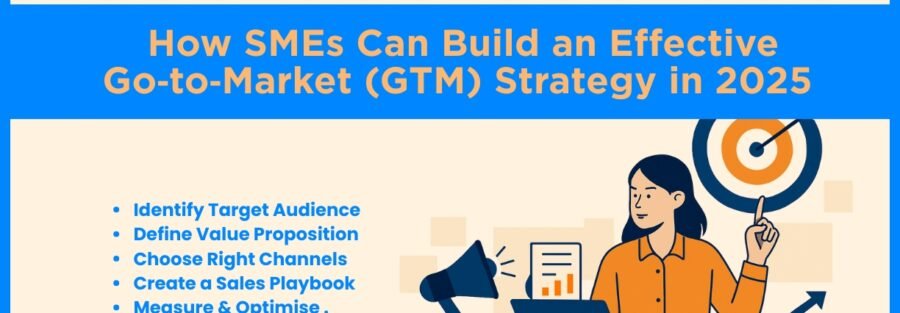In 2025, small and medium-sized enterprises (SMEs) are navigating a market that’s fast-changing, tech-driven, and hyper-competitive. Whether you’re launching a new product or entering a new market, having a well-thought-out Go-to-Market (GTM) strategy isn’t just smart—it’s essential. This strategic plan aligns your product or service with the right audience, at the right time, using the right messaging and channels. Without it, even the best innovations can fall flat. So, how can SMEs effectively build a GTM strategy in 2025? Let’s dive in.
Understanding Go-to-Market (GTM) Strategy
Definition and Core Elements
A GTM strategy is a tactical plan that outlines how a business will reach target customers and achieve competitive advantage. It includes your product positioning, value proposition, target audience, sales and marketing tactics, and distribution strategy.
GTM vs. Marketing Strategy
Don’t confuse GTM with a general marketing strategy. While marketing is ongoing, GTM is specific—it’s all about launching something new or entering a new market. Think of GTM as your big entry play.
Why GTM Matters in 2025
With AI, automation, and customer expectations rapidly evolving, your strategy needs to be data-backed, agile, and personalized. GTM offers a roadmap to avoid wasted effort and missed opportunities.
Market Research is the Foundation
Identifying Target Customers
Before you even begin planning, ask: Who are we selling to? Use surveys, interviews, and web analytics to identify your ideal customer group.
Analyzing Market Trends
Stay ahead of industry shifts. Explore consumer behavior, upcoming technologies, and demand gaps. In 2025, trends like sustainability, personalization, and digital-first experiences are dominant.
Understanding the Competitive Landscape
A thorough competitor analysis helps you identify gaps and differentiate your offering. Tools like SEMrush, Ahrefs, or SimilarWeb can help you monitor your competition.
Defining Your Value Proposition
Solving the Customer’s Problem
Your product must be a solution. What pain point does it address? Make your value crystal clear to the end-user.
Crafting a Unique Selling Proposition (USP)
What makes your offering different or better? Your USP should resonate deeply with your audience and reflect your brand promise.
Choosing the Right Market Segments
B2B vs. B2C Markets
Your GTM approach will vary if you’re selling to businesses vs. consumers. Understand their decision-making processes and buyer journeys.
Niche vs. Broad Market Entry
Starting niche lets you fine-tune your product and messaging. Once established, you can scale into broader markets.
Building the Ideal Customer Profile (ICP)
Demographics and Behaviors
Age, income, job roles, geography—all of this matters. Also, explore behavior patterns such as buying habits and online activity.
Pain Points and Goals
What keeps your customers up at night? What are they trying to achieve? Your GTM plan must speak directly to these issues.
Selecting the Best Sales Channels
Direct vs. Indirect Sales
Will you sell through your own website, in-store, or use resellers or affiliates? Each has pros and cons depending on your resources and product type.
Online Platforms and Marketplaces
In 2025, platforms like Amazon, Shopify, and niche B2B marketplaces are booming. Choose ones that align with your industry and customer behavior.
Channel Partner Strategies
Strategic partnerships can unlock new markets quickly. Look for value-aligned brands or services for co-marketing or distribution.
Pricing and Packaging Strategies
Value-Based Pricing
Rather than cost-plus pricing, consider what your customers are willing to pay based on the value your product delivers.
Tiered Packages for Flexibility
Offering multiple pricing plans (starter, pro, enterprise) can capture a broader audience and allow for future upsells.
Creating a Compelling Messaging Framework
Aligning with Customer Needs
Your messaging should focus less on features, more on benefits. Make it emotional and outcome-driven.
Consistency Across Channels
From website copy to social media, consistency builds trust. Your GTM plan should have a clear messaging guide.
Marketing Plan and Launch Strategy
Pre-Launch Buzz
Use teasers, waitlists, and exclusive previews. Engage influencers and industry media to create anticipation.
Launch Campaign Ideas
Leverage content marketing, webinars, email sequences, PPC ads, and press releases. Make a splash.
Post-Launch Support
The launch is just the beginning. Continue engaging users with onboarding, tutorials, and updates.
Sales Enablement and Training
Equipping Your Team
Your sales team needs the right tools—product knowledge, objection handling scripts, and lead scoring systems.
Creating Sales Collateral
Make your sales decks, one-pagers, and FAQs crystal clear and visually appealing.
Measuring GTM Success
Key Metrics to Track
Focus on CAC (Customer Acquisition Cost), LTV (Lifetime Value), conversion rates, and customer satisfaction.
Using Feedback for Iteration
Customer feedback is gold. Use it to refine your offering and GTM strategy continuously.
Leveraging Technology and Tools
CRM, Marketing Automation & Analytics
Tools like HubSpot, Zoho, Mailchimp, and Google Analytics can streamline operations and deliver insights.
AI Tools for SMEs in 2025
AI is a game-changer. Use AI for customer insights, content creation, and predictive lead scoring to enhance your GTM.
Common GTM Mistakes SMEs Should Avoid
Misaligned Messaging
If your message doesn’t match your audience’s needs, it won’t resonate—no matter how good your product is.
Poor Market Research
Skipping research leads to bad decisions. Always start with data.
Ignoring Customer Feedback
What your users say post-launch is vital. Use their insights to adjust quickly.
Conclusion
In 2025, a strong GTM strategy could be the make-or-break moment for your SME. It’s not just about getting your product to market—it’s about getting it to the right market in the right way. Invest in research, understand your customer deeply, pick the right channels, and leverage the latest tools to stay ahead. A well-crafted GTM strategy gives your business the edge it needs to grow fast and smart.




